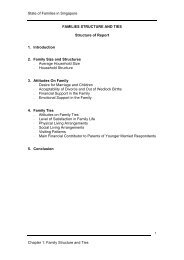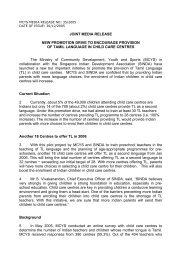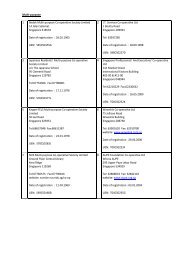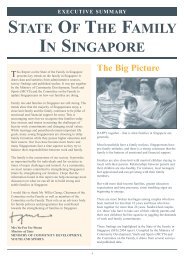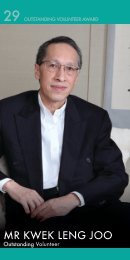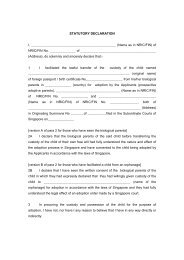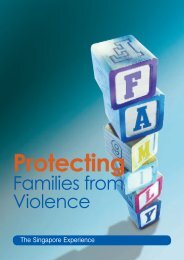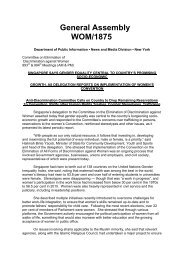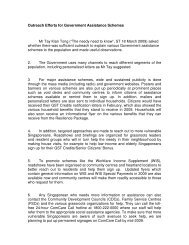Chapter 6 Opportunities for Seniors - Ministry of Social and Family ...
Chapter 6 Opportunities for Seniors - Ministry of Social and Family ...
Chapter 6 Opportunities for Seniors - Ministry of Social and Family ...
Create successful ePaper yourself
Turn your PDF publications into a flip-book with our unique Google optimized e-Paper software.
Chart 6.1: Statistics on Perception <strong>of</strong> <strong>Seniors</strong><strong>Seniors</strong> play an active role in the societyGenerally, seniors in Singapore are nowmore active<strong>Seniors</strong> are well integrated with the rest <strong>of</strong>the society<strong>Seniors</strong> are likely to be weak, frail <strong>and</strong> ill20042003<strong>Seniors</strong> are generally not as happy asyounger peopleIt is difficult to communicate with seniors0% 10% 20% 30% 40% 50% 60% 70% 80%Source: Attitudinal <strong>and</strong> Perception Survey on Ageing <strong>and</strong> Elderly, Year 2003 & 20046. Surveys 1 over the last few years show improvements in the perception<strong>of</strong> seniors. In addition, seniors are increasingly leading more activelifestyles. Sports participation rate <strong>of</strong> seniors has increased from 33% in2001 to 37% in 2005 2 .1 Attitudinal <strong>and</strong> Perception Survey on Ageing <strong>and</strong> Elderly 2003 <strong>and</strong> 20042 Singapore Sports CouncilCommittee on Ageing Issues: Report on the Ageing Population 54
Chart 6.2: Statistics on <strong>Seniors</strong> Leading Active LifestylesI do volunteer work <strong>and</strong> share my time <strong>and</strong>skills to help other peopleI learn new things constantly <strong>and</strong> keep up todate on current affairs20042003I take care <strong>of</strong> my gr<strong>and</strong>children <strong>and</strong> help outwith household chores0% 10% 20% 30% 40% 50% 60%Source: Attitudinal <strong>and</strong> Perception Survey on Ageing <strong>and</strong> Elderly, Year 2003 & 2004CAI’s Focus7. Building on the ef<strong>for</strong>ts <strong>of</strong> the IMC, the Committee on Ageing Issues(CAI) continues to emphasise the importance <strong>of</strong> maintaining an activelifestyle. To achieve this, the CAI recommends that more qualityprogrammes, lifestyle products <strong>and</strong> services be developed <strong>for</strong> seniors by theGovernment, people <strong>and</strong> private sectors. There can also be more systematicoutreach by the various parties to engage seniors in activities <strong>and</strong>programmes.8. The four key thrusts <strong>for</strong> seniors to be engaged in active lifestyle <strong>and</strong>well-being are:(i) promote healthy living;(ii) encourage the development <strong>of</strong> active lifestyles <strong>and</strong> socialnetworks;(iii) encourage seniors to continue to learn <strong>and</strong> contribute to society;<strong>and</strong>(iv) build strong family ties.Committee on Ageing Issues: Report on the Ageing Population 55
Funding Support <strong>and</strong> OutreachPromote ground-up initiatives9. We can look <strong>for</strong>ward to a variety <strong>of</strong> opportunities in the community<strong>for</strong> seniors to lead an active lifestyle. <strong>Seniors</strong> can choose to be engaged insports, to become a volunteer or to take up lifelong learning among manyother activities. They can also choose to join social events with friends orenjoy family time with their relatives such as children <strong>and</strong> gr<strong>and</strong>children.We feel that the Government has a role in supporting the development <strong>of</strong>these interesting programmes <strong>for</strong> seniors.10. The CAI recommends that the Government should commit $10million over five years to set up the ‘Golden <strong>Opportunities</strong>! (GO!)Fund’ to seed more programmes <strong>and</strong> activities <strong>for</strong> seniors <strong>and</strong> byseniors. The Government should be prepared to provide additional resourcesif need be.11. The GO! Fund can be tapped by seniors who come together toorganise activities with themes on healthy living, social networking, learning<strong>and</strong> contributing <strong>and</strong> intergenerational bonding. Organisations that organiseactivities or programmes <strong>for</strong> seniors can also tap on this fund. This fundcould enable seniors to be continually enriched by the various activities <strong>and</strong>create a vibrant sector <strong>of</strong> opportunities <strong>for</strong> seniors. The CAI recommendsthat this fund be operated on a co-funding basis to encourage communityownership <strong>for</strong> the activities.Systematically in<strong>for</strong>m seniors <strong>of</strong> activities12. The CAI notes that though there is a range <strong>of</strong> activities available inthe community <strong>for</strong> seniors, some seniors may not be aware <strong>of</strong> these activities<strong>and</strong> thus do not participate in them. The CAI recommends that theGovernment systematically in<strong>for</strong>m older persons <strong>of</strong> these activities. Forinstance, the Government could publish an active lifestyle magazine to bemade readily available to older persons. The Government can in<strong>for</strong>m <strong>and</strong>encourage seniors to participate in these activities <strong>and</strong> programmes,including volunteering <strong>and</strong> employment opportunities at certain life stages(e.g. 55 years old when a person can withdraw his CPF money).Committee on Ageing Issues: Report on the Ageing Population 56
Feature Highlight: Picture <strong>of</strong> a senior teaching gateball17. More public spaces within housing estates should also be madeavailable <strong>for</strong> sporting activities <strong>for</strong> seniors. This will make it convenient <strong>for</strong>seniors to engage in sports without travelling great distances. At the sametime, we would want seniors to participate fully in society <strong>and</strong> be sociallyintegrated within their families <strong>and</strong> in the community. The CAIrecommends that the Government should ensure that all public spacesin housing estates such as parks <strong>and</strong> sporting venues have facilities thatcater to the whole family, including seniors. Examples would includegateball courts, open space suitable <strong>for</strong> taiji quan <strong>and</strong> other exercises.18. Leading a healthy lifestyle has to begin from young so that the habit<strong>of</strong> healthy living is carried into adulthood <strong>and</strong> into old age. There areongoing health education ef<strong>for</strong>ts by the Health Promotion Board (HPB) inschools, workplaces <strong>and</strong> the community at large, to raise awareness amongSingaporeans on the importance <strong>of</strong> healthy living.19. A national Community Health Screening Programme was launched inJuly 2000 <strong>for</strong> those aged 50 years <strong>and</strong> above. Under this programme, onecould be screened <strong>for</strong> high blood pressure, diabetes <strong>and</strong> high bloodcholesterol within the community at venues like void decks <strong>and</strong> communitycentres. Health promotion materials are also distributed during the healthscreening sessions. Nevertheless, the CAI feels that more can be done t<strong>of</strong>urther raise public’s awareness on the need to live a healthy lifestyle.Committee on Ageing Issues: Report on the Ageing Population 58
30. The CAI would like to see the volunteerism rate <strong>for</strong> seniors doublefrom the current 4% to 8% by the year 2010 <strong>and</strong> 15% by 2030. To achievethis, new ways <strong>of</strong> engaging seniors should be continuously identified <strong>and</strong>promoted. Apart from identifying opportunities, well structured volunteerrecruitment plans <strong>and</strong> training on volunteer management will help the hostorganisations attract <strong>and</strong> retain senior volunteers.31. The CAI recommends that the National Volunteer <strong>and</strong>Philanthropy Centre (NVPC) work with partners to develop <strong>and</strong>promote more volunteering opportunities <strong>for</strong> seniors. For example,seniors could be recruited as coaches / exercise leaders / game <strong>of</strong>ficials <strong>for</strong>community sports events. These seniors could also volunteer as sportscoaches in schools. In the school setting, seniors could be involved instudent enrichment programmes.32. <strong>Seniors</strong>’ interest to volunteer should not be hindered by the lack <strong>of</strong>awareness. As part <strong>of</strong> the outreach ef<strong>for</strong>ts, there should be more intensivepublic education such as campaigns on senior volunteering. NVPC could setup a library <strong>of</strong> in<strong>for</strong>mation <strong>and</strong> resource kits to allow easy reference byorganizations interested in recruiting senior volunteers. A best practice guide<strong>for</strong> Non-Pr<strong>of</strong>it Organisations detailing recommended <strong>and</strong> positive volunteermanagement practices (including appreciation <strong>of</strong> volunteers) could also beestablished.Provide <strong>and</strong> promote lifelong learning opportunities33. Lifelong learning helps seniors maintain mental alertness 8 <strong>and</strong>relevance in society. Continuous learning can help to prevent dementia inolder persons 9 . As future seniors get more educated <strong>and</strong> financially secure,more will seek learning opportunities to enrich themselves.8 Michael Brickey. (2001). “The extended life: Four strategies <strong>for</strong> healthy longevity”, TheFuturist, 35, 5: 52.9 Shankar Vedantam. “Mind Games May Trump Alzheimer's: Study Cites Effects OfBridge, Chess”, Washington Post, Thursday, June 19, 2003, Page A01.(Source: http://www.alzstl.org/news%20items/mind_games_may_trump_alzheimer.htm)Committee on Ageing Issues: Report on the Ageing Population 62
34. Lifelong learning is common in developed countries. There areseveral Third Age Universities – Kobe Silver College in Japan, theUniversity <strong>for</strong> Third Age in Cambridge in United Kingdom <strong>and</strong> theUniversity <strong>of</strong> West Florida Center <strong>for</strong> Lifelong Learning in USA. In SouthKorea, the Centre <strong>for</strong> Lifelong Education under the Korean EducationalDevelopment Institute conducts research on lifelong education.35. In Singapore, lifelong learning has been promoted by the <strong>Ministry</strong> <strong>of</strong>Manpower since year 2000. The focus has been on employability relatedlearning <strong>and</strong> the target audience were the less-skilled <strong>and</strong> lower-educatedSingaporeans. For instance, the theme in 2003 was “Lifelong Learning <strong>for</strong>Employability”.36. Besides employability related learning, we <strong>for</strong>esee that some seniors,especially the more educated ones, would want to pursue learning <strong>for</strong>personal interest as opposed to employability.37. In Singapore, there are courses <strong>for</strong> seniors organised by thecommunity. For example, Marine Parade <strong>Family</strong> Service Centre has startedthe YAH! Community College, which <strong>of</strong>fers courses such as life skillsdevelopment <strong>and</strong> in<strong>for</strong>mation <strong>and</strong> communication technology. <strong>Seniors</strong> whoare 55 years old <strong>and</strong> above take up lifelong learning certificate courses in thecommunity college. The Centre <strong>for</strong> Lifelong Learning at the NationalUniversity <strong>of</strong> Singapore Extension <strong>of</strong>fers courses in language, literature <strong>and</strong>culture. The CAI feels that more learning opportunities should be madeavailable to seniors.Committee on Ageing Issues: Report on the Ageing Population 63
Feature Highlight: YAH! Community CollegeThe YAH! Community College aims to promote Life-long learning as a means towardsproductive <strong>and</strong> active ageing among seniors in the community. <strong>Seniors</strong> aged 55 years <strong>and</strong>above are able to take up certificate courses at the community college. During theircourse <strong>of</strong> learning, the seniors participate in volunteer work, community activities <strong>and</strong>take up electives such as line dancing, yoga <strong>and</strong> creative painting. These senior studentswill then be recruited as “Active <strong>Seniors</strong> Ambassadors” in the various areas <strong>of</strong> volunteerwork.38. The CAI recommends that our universities <strong>and</strong> polytechnicsprovide more learning opportunities to seniors. The courses should beshort <strong>and</strong> non-examinable, <strong>and</strong> on topics that may be <strong>of</strong> interest to seniors.We encourage universities to consider allowing seniors to attend lectures<strong>and</strong> seminars, as well as have access to course curriculum <strong>and</strong> materials atno charge. These initiatives would facilitate like-minded seniors to <strong>for</strong>mhome-based study groups, allowing seniors the opportunity to learn <strong>and</strong>pursue their interest areas with minimal expenses.39. Libraries are established centres <strong>of</strong> learning. Our libraries are locatedwithin housing estates <strong>and</strong> easily accessible to the public. All our publiclibraries are elder-friendly. There are lifts <strong>and</strong> access ramps <strong>for</strong> wheelchairboundpersons. In addition, the book shelves <strong>and</strong> height <strong>of</strong> placement <strong>of</strong>books are arranged such that it would be convenient <strong>for</strong> seniors to search <strong>and</strong>reach <strong>for</strong> books. To make the library completely elder-friendly, the CAIrecommends that the NLB provide more large print books <strong>and</strong> audiovisualmaterials that appeal to seniors.Committee on Ageing Issues: Report on the Ageing Population 64
Build on Strong <strong>Family</strong> Ties40. Strong families provide an important pillar <strong>of</strong> support <strong>for</strong> the nation.Families are the first line <strong>of</strong> support <strong>for</strong> seniors. Children have theresponsibility to take care <strong>of</strong> their elderly parents, providing them withemotional support <strong>and</strong> looking after their needs. Elderly parents can play acontributing role in the family, <strong>for</strong> example, by playing an active role as agr<strong>and</strong>parent. Strong family ties also enable seniors to transmit values,wisdom <strong>and</strong> family traditions to the next generation.41. The Government recognises the need <strong>for</strong> work life balance in support<strong>of</strong> stronger family ties. Increasingly, human resource practices are becomingfamily-friendly. The civil service is now on a five-day work week. In theworkplace, pro-family practices such as flexi-work arrangements, extendedmaternity leave <strong>and</strong> childcare leave have been introduced.42. Some <strong>of</strong> the Government’s existing policies do encourageintergenerational bonding within families. Some initiatives include theCentral Provident Fund (CPF) <strong>Family</strong> Housing Grant, tax incentives <strong>for</strong>children looking after aged parents <strong>and</strong> CPF top-ups among familymembers. These measures provide support <strong>for</strong> family members to care <strong>for</strong>one another.43. In addition, intergenerational programmes are important to promotefamily bonding. In Singapore, organisations including voluntary welfareorganisations, schools <strong>and</strong> even the private sector had begun championingsuch programmes since 2002. Fei Yue Community Services, <strong>for</strong> examplehad organised numerous intergenerational activities, an example <strong>of</strong> which isa community involvement partnership programme 10 .44. In the HDB Sample Household Survey 2003, findings showed that themajority <strong>of</strong> seniors (90%) received visits from their married children at leastonce a month. The CAI recommends the Government build on strongfamily ties to ensure that the family continues to be the first line <strong>of</strong>support.10 Fei Yue Community Services: “ Generations Together”. This programme is apartnership with a school, a neighbourhood link <strong>and</strong> a retiree centre. This programme wasawarded one <strong>of</strong> the best three Gr<strong>and</strong>parenting <strong>and</strong> Intergenerational BondingProgrammes in 2003.Committee on Ageing Issues: Report on the Ageing Population 65
Feature Highlight: Yum Cha with Gr<strong>and</strong>parentsYum Cha with Gr<strong>and</strong>parents was first introduced by the Life Community ServicesSociety. This is a 12-month intergenerational bonding programme which bringsgr<strong>and</strong>parents, parents, gr<strong>and</strong>children <strong>and</strong> student volunteers together at a tea party once amonth. The bonding developed among the generations was strong as the generations hadthe opportunity to bond <strong>and</strong> learn about each other every month <strong>for</strong> a year. After the firstyear, another organization, Bethesda Care, adopted the idea <strong>and</strong> ran the programme aswell to continue the <strong>for</strong>ged friendship.45. We feel that sports is an activity that could involve the whole family.Currently, seniors enjoy concessionary entrance fees at swimming pools <strong>and</strong>gymnasiums. The CAI recommends that SSC <strong>and</strong> People’s Association(PA) should introduce family passes to encourage multi-generationaluse <strong>of</strong> sports facilities. The family passes should be sold at concessionaryrates <strong>and</strong> apply to all opening hours so as to encourage seniors to participatein sporting activities together with other family members. In addition, familypasses could also be introduced to other community events such as carnivals<strong>and</strong> per<strong>for</strong>mances.46. Advocacy <strong>for</strong> greater intergenerational (IG) bonding initiatives is alsorequired. We will need champions <strong>for</strong> IG in schools, the community <strong>and</strong>workplace. These champions will help drive the mindset shift towards theimportance <strong>of</strong> intergenerational bonding <strong>and</strong> cohesion.Committee on Ageing Issues: Report on the Ageing Population 66
47. We feel that there should be more activities that involve higherinteraction opportunities across the generations. To strengthenintergenerational bonds, the CAI recommends that MCYS organise trainingcourses to support service providers in the development <strong>of</strong> IG programmes,<strong>and</strong> create greater public awareness <strong>of</strong> intergenerational cohesion throughpublic campaign. Also, conferences <strong>and</strong> network sessions should beorganised on a regular basis, so as to facilitate sharing <strong>of</strong> best practicesamong our partners such as pr<strong>of</strong>essionals, youth leaders <strong>and</strong> agencies.Committee on Ageing Issues: Report on the Ageing Population 67



